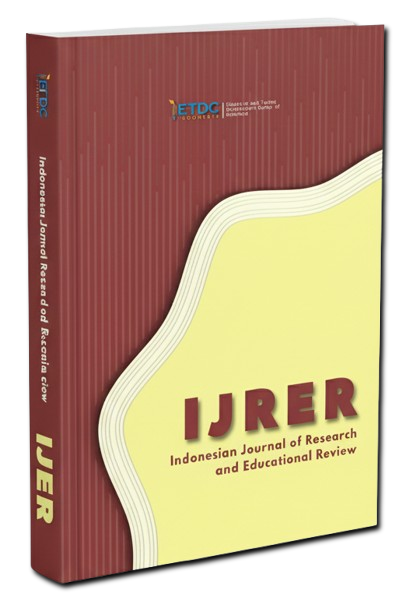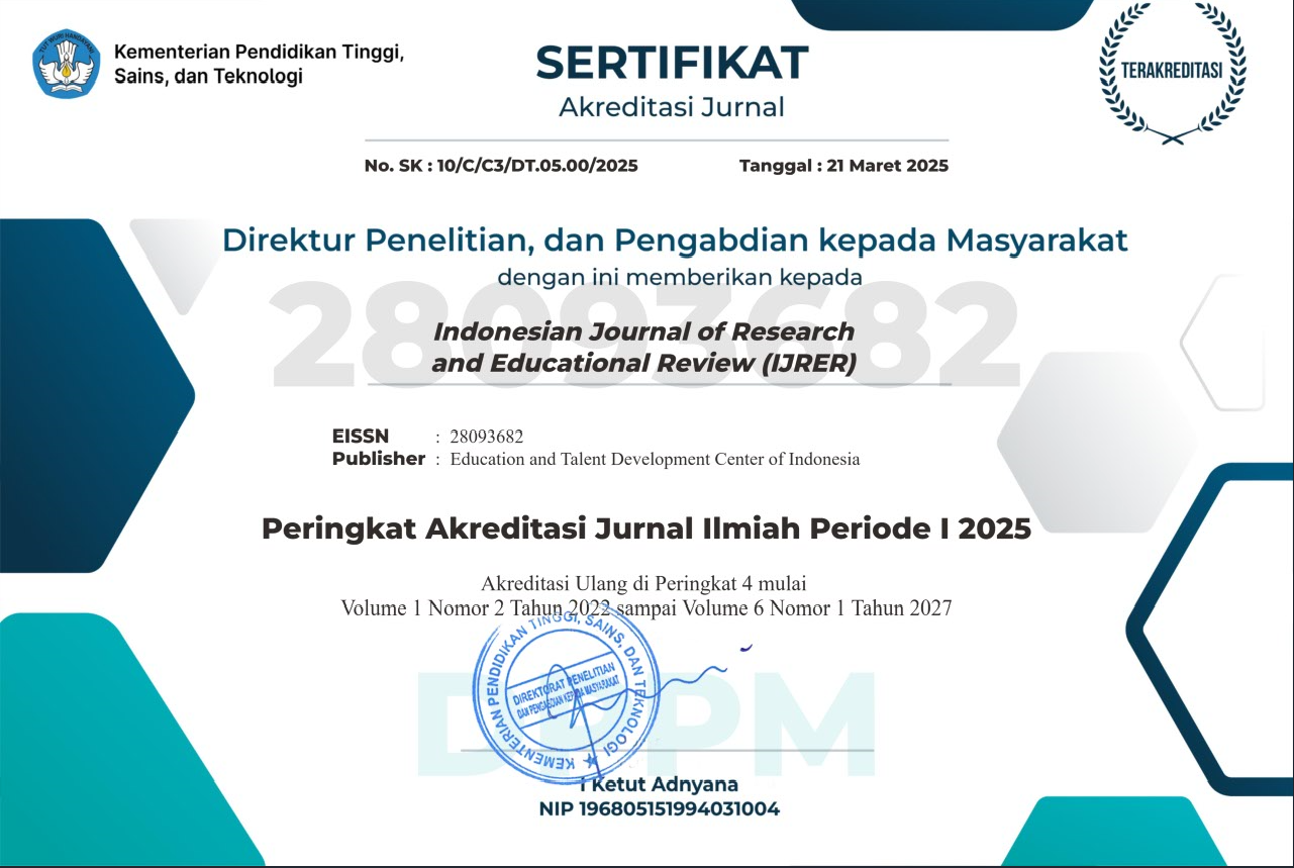Mathematical Reasoning Ability in Solving Flat Geometry Problems Based on Camper Type Adversity Quotient in Junior High School Students
DOI:
https://doi.org/10.51574/ijrer.v2i3.3503Keywords:
Adversity Quotient, Camper, Geometry Plane, Mathematical Reasoning AbilityAbstract
This research employed a descriptive qualitative approach to analyse the mathematical reasoning abilities of junior high school students when solving plane geometry problems, specifically focussing on their camper type adversity quotient. The research subjects consist of two students who were selected based on the Adversity Response Profile (ARP) questionnaire scores, namely two camper subjects with moderate scores. Furthermore, the researcher gave mathematical reasoning test questions on the quadrilateral material and conducted interviews with each subject. The researcher checked the validity of the data by using source triangulation. The analysis of mathematical reasoning ability is based on three indicators: finding mathematical patterns to make generalisations, performing mathematical manipulations, and drawing conclusions while compiling evidence and providing reasons for the correctness of the solution. The results of this research showed camper-type students used inductive reasoning, which is good in determining mathematical patterns, but cannot make appropriate generalisations of the patterns that were found. In doing mathematical manipulation, there are camper-type students who use trial and error strategies in solving geometry plane problems. Camper-type students can draw conclusions from a geometry plane problem but have difficulties in gathering evidence and providing reasons for the correct problem-solving.
References
Ardhiyanti, E., Sutriyono, & Pratama, F. W. (2019). Deskripsi Kemampuan Penalaran Siswa dalam Pemecahan Masalah Matematika pada Materi Aritmatika Sosial. Jurnal Cendekia; Jurnal Pendidikan Matematika, 3(1), 90-103.
As'ari, A. R., Tohir, M., Valentino, E., Imron, Z., & Taufik, I. (2017). Matematika: Kementerian Pendidikan dan Kebudayaan. Jakarta: Kementerian Pendidikan dan Kebudayaan.
Asdarina, O., & Ridha, M. (2020). Analisis Kemampuan Penalaran Matematis Siswa dalam Menyelesaikan Soal Setara PISA Konten Geometri. Jurnal Numeracy, 7(2), 192-206. https://doi.org/10.46244/numeracy.v7i2.1167
Astiati, S. D. (2020). Analisis Kemampuan Penalaran Matematis Siswa MTs dalam Menyelesaikan Soal-Soal Geometri. Jurnal Ilmu Sosial dan Pendidikan, 4(3), 399-411.
Annas, S., Djadir, & Hasma, S. M. (2018). The Abstraction Ability in Constructing Relation Within Triangles by The Seventh Grade Students of Junior High School. Journal of Physics: Conference Series. https://doi.org/10.1088/1742-6596/954/1/012029
Bird, J. (2004). Matematika Dasar Teori dan Aplikasi Praktis. Jakarta: Erlangga.
Brodie, K. (2009). Teaching Mathematical Reasoning in Secondary School Classrooms (Vol. 775). New York: Springer Science & Business Media.
Fadillah, A. (2019). Kemampuan Penalaran Deduktif Matematis Siswa. JTAM: Jurnal Teori dan Aplikasi Matematika, 3(1), 15-21. https://doi.org/10.31764/jtam.v3i1.752
Gultom, C. I., & Saputro, D. R. S. (2022). Students’ Mathematical Reasoning Skills in Solving Mathematical Problems. JPI (Jurnal Pendidikan Indonesia), 11(3), 542-551. https://doi.org/10.23887/jpiundiksha.v11i3.42073
Hidayah, I., Dwijanto, & Istiandaru, A. (2018). Manipulatives and Question Series for Elementary School Mathematics Teaching on Solid Geometry. International Journal of Instruction, 11(3), 649-662. https://doi.org/10.12973/iji.2018.11344a
Kusumawardani, D. R., Wardono, & Kartono. (2018). Pentingnya Penalaran Matematika dalam Meningkatkan Kemampuan Literasi Matematika. PRISMA 1, 588-595. https://journal.unnes.ac.id/sju/prisma/article/view/20201
Lestari, N. R. (2019). Analisis Proses Penalaran Matematis Siswa SMP dalam Menyelesaikan Masalah Matematika Ditinjau dari Adversity Quotient. Thesis, Universitas Muhammadiyah Malang.
Lithner, J. (2017). Principles for designing mathematical tasks that enhance imitative and creative reasoning. Zdm, 49(6), 937-949. https://doi.org/10.1007/s11858-017-0867-3
Masingila, J. O., & Olanoff, D. (2022). Who teaches mathematics content courses for prospective elementary teachers in the USA? Results of a second national survey. Journal of Mathematics Teacher Education, 25(4), 385-401. https://doi.org/10.1007/s10857-021-09496-2
Molan, B. (2017). Logika Ilmu dan Seni Berpikir Kritis. Jakarta: PT Indeks.
Mullis, I. V., Martin, M. O., & Foy, P. (2012). TIMSS 2011 International Result in Mathematics. United States: TIMSS & PIRLS International Study Center.
Mullis, I. V., Martin, M. O., Foy, P., & Hooper, M. (2015). TIMSS 2015 International Results in Mathematics. TIMSS & PIRLS International Study Center.
Muslimin, & Sunardi. (2019). Analisis Kemampuan Penalaran Matematika Siswa SMA pada Materi Geometri Ruang. KREANO, 10(2), 171-178. http://dx.doi.org/10.15294/kreano.v10i2.18323
Nasrullah, Alimuddin, & Talib, A. (2021). Using HTML-Based Worksheet to Support Students in Active Mathematics Learning. Journal of Physics: Conference Series. http://dx.doi.org/10.1088/1742-6596/1899/1/012165
Nurhayati, & Fajrianti, N. (2012). Pengaruh Adversity Quotient (AQ) dan Motivasi Beprestasi terhadap Prestasi Belajar Matematika. Jurnal Formatif, 3(1), 72-77.
Parvathy, U., & Praseeda, M. (2014). Relationship between Adversity Quotient and Academic Problems among Student Teachers. IOSR-JHSS: IOSR Journal Of Humanities And Social Science, 19(11), 23-26.
Pribadi, A., Somakim, & Yusup, M. (2017). Pengembangan Soal Penalaran Model TIMSS pada Materi Geometri dan Pengukuran SMP. Histogram: Jurnal Pendidikan Matematika, 1(2), 115-128.
Salmina, M., & Nisa, S. K. (2018). Kemampuan Penalaran Matematis Siswa Berdasarkan Gender pada Materi Geometri. Jurnal Numeracy, 5(1), 41-48. https://doi.org/10.46244/numeracy.v5i1.304
Saputri, I., Susanti, E., & Aisyah, N. (2017). Kemampuan Penalaran Matematis Siswa Menggunakan Pendekatan Metaphorical Thinking pada Materi Perbandingan Kelas VIII di SMPN 1 Indralaya Utara. Jurnal Elemen, 3(1), 15-24.
Sari, A. P. (2019). Analisis Penalaran Deduktif atau Induktif Siswa dalam Menyelesaikan Masalah Matematika Ditinjau dari Adversity Quotient. PhD Tesis, UIN Sunan Ampel Surabaya, Surabaya.
Sari, N. I., Subanji, & Hidayanto, E. (2016). Daignosa Kesulitan Penalaran Matematis Siswa dalam Menyelesaikan Masalah Pola Bilangan dan Pemberian Scaffolding. KNPMP I (pp. 385-394). Surakarta: Universitas Muhhamadiyah Surakarta.
Stoltz, P. G. (2020). Adversity Quotient: Mengubah Hambatan Menjadi Peluang. Jakarta: PT Grasindo.
Suharjana, A., Markaban, & WS, H. (2009). Geometri Datar dan Ruang di SD. DI. Yogyakarta: PPPPTK Matematika.
Suyanto, S. (2005). Konsep Dasar Pendidikan Anak Usia Dini. Jakarta: Departemen Pendidikan Nasional, Direktorat Jenderal Perguruan Tinggi, Direktorat Pembinaan Pembinaan Pendidikan Tenaga Kependidikan dan Ketenagaan Perguruan Tinggi.
Talib, A. (2017). Implementasi Perangkat Pembelajaran Berbasis Masalah yang Memanfaatkan Sumber Belajar Autentik pada Pembelajaran Matematika SD. Jurnal Parameter, 29(2), 134-144. https://doi.org/10.21009/parameter.292.02
Thalhah, S. Z., Upu, H., & Dassa, A. (2013). Eksplorasi Komunikasi dan Penalaran Matematika dalam Pembelajaran Kooperatif Tipe Jigsaw Siswa Kelas VIII SMP Pesantren IMMIM Putra Makassar. MaPan: Jurnal Matematika dan Pembelajaran, 1(1), 19-39. https://journal3.uin-alauddin.ac.id/index.php/Mapan/article/view/1124
Thompson, D. R., Senk, S. L., & Johnson, G. J. (2012). Opportunities to Learn Reasoning an Proof in High School Mathematics Textbooks. Journal for Research in Mathematics Education, 43(3), 253-295. https://doi.org/10.5951/jresematheduc.43.3.0253
TS, U., & Wiyoto, J. (2009). Kapita Selekta Pembelajaran Geometri Datar Kelas VII di SMP. DI. Yogyakarta: PPPPTK Matematika.
Wahyuningtyas, F., Suyitno, H., & Asikin, M. (2020). Student’ s Creative Thinking Skills Viewed by Adversity Quotient and Mathematics Anxiety in Grade VIII. Unnes Journal of Mathematics Education Research, 9(2), 190-198. https://journal.unnes.ac.id/sju/ujmer/article/view/33171
Wardani, Y., & Mahmudi, A. (2019). A profile of vocational high school students’ adversity quotient towards mathematics. In Journal of Physics: Conference Series (Vol. 1320, No. 1, p. 012062). IOP Publishing.
Winarti, S., & Murtiyasa, B. (2016). Analisis Kemampuan Penalaran Siswa dalam Menegerjakan Soal Serupa PISA pada Siswa Kelas VIII. Surakrta: Universitas Muhammadiyah Surakarta.
Zubainur, C. M. (2020). The thinking process of quitter students in solving open-ended mathematical problems. In Journal of Physics: Conference Series (Vol. 1460, No. 1, p. 012007). IOP Publishing.
Downloads
Published
How to Cite
Issue
Section
License
Copyright (c) 2023 Nirmala Dewi, Ahmad Talib, Nurwati Djam’an

This work is licensed under a Creative Commons Attribution-ShareAlike 4.0 International License.














1.png)













